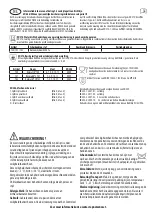
Article 742 requirements of EN ISO 14644-1: ISO Class 5, GMP A/B.
This glove meets the following requirements of EN 455:
EN 455-1 : 2001-01;
completely
EN 455-2 : 2011-2-05; completely
EN 455-3 : 2007-03,
5.3 proteins extractable
EN 455-4 : 2009-10;
5.2 Accelerated determination of shelf-life
The glove is not a medical device within the meaning of Directive 93/42/EEC.
Article
Name
Size
EN 388
740
Dermatril® 740
6, 7, 8, 9, 10, 11
000X
741
Dermatril® L 741
7, 8, 9, 10, 11
000X
742
Dermatril® LR 742
7, 8, 9, 10, 11
000X
The CE marking on this glove means that it meets the essential requirements for
in the European Directive EEC 89/686 concerning Individual Protection
Equipment (IPE): Harmlessness-Comfort-Dexterity-Sturdiness. Protective Gloves
conform to the EN 420. Approved to EN 374 according to Article 10 of Directive
89/686/EEC: IFA, Alte Heerstraße 111, D-53757 St. Augustin, Identification
number: 0121
EN 374, Waterproof gloves and little protection against chemical hazards
EN 374-3 was rated positively and certified by notified body. When used with chemicals the protective glove should be checked for adequate permeation.
Surveillance after 11 B of Directive 89/686/EEC, chemical risks according to
EN 374: same location as type test. The identification number for testing and
certification centre 0121 for EC type testing and monitoring of quality assurance
measures relates solely to the content of EN 374-1: 2003 and the PPE Directive
89/686/EEC.
GB
Information brochure to Section 1.4 of Annex II to Directive 89/686/EEC for personal protective equipment in Category III
Gloves conform to Regulation (EC) No 1935/2004.
Approved for short-term, direct contact with all food types.
EN 388, Mechanical risks
1st digit Abrasion resistance
(min. 0; max. 4)
2nd digit Cut resistance
(min. 0; max. 5)
3rd digit Tear strength resistance
(min. 0; max. 4)
4th digit Puncture resistance
(min. 0; max. 4)
X = Cannot be tested
WARNING !
Resistance to the chemicals listed was determined under laboratory
conditions and may be adversely affected by changes to physical
properties such as temperature, abrasion, stretching, etc.
When using highly corrosive chemicals, degradation is the most
important factor in the choice of protective gloves.
These protective gloves provide no protection against extreme cold
(<- 5 °C), heat (> 50 °C), electricity.
Do not use in the vicinity of moving machine parts. Risk of being
drawn into the machine.
Unusable when the gloves are cracked, porous and stiff.
Allergy Notice:
The Gloves may contain traces of dithiocarbamates.
Use:
The protective gloves you wear must be of the correct size. Note
that using undergloves may result in some usage restrictions. Check
the protective gloves for damage before you use them. Prevent the
penetration of pollutants over the edge of the glove. Prevent
carryover of contaminants located on the glove and the cross-
contamination when removing gloves.
Cleaning:
The specified gloves are not washable. Do not
use any chemicals or sharp implements when cleaning
(wire brushes, sandpaper, etc.). Dirt brush off.
Expiry date:
With proper storage, no reduction in performance
levels within 36 months.
Storage /Transport:
Flat, dry, dark, with no additional weight load
in its original packaging, at a temperature of 5 °C - 25 °C. Protect from
sunlight and ozone.
Disposal:
If not contaminated with chemicals, gloves can be
disposed of in the household waste. If the gloves have been exposed
to chemicals, follow the disposal instructions of the manufacturer of
the chemicals.
For further information please contact.
Article
Chemical
Penetration time in min.
Protection index
740 / 741 / 742
Sodium hydroxide 40 %
> 480
6
EN 374, Protection against bacteriological contamination
KCL chemical protective gloves have been
penetration
-tested to the highest performance level (3) set out in EN 374-2.
This quality limit equates to an AQL < 0.65.




































